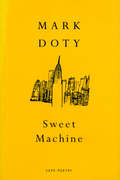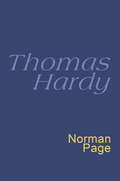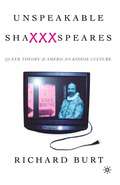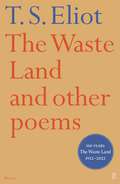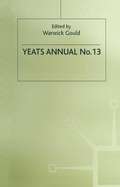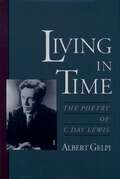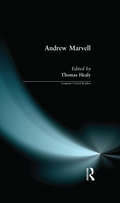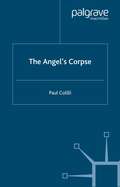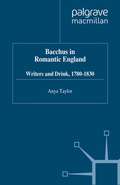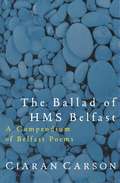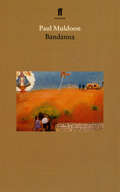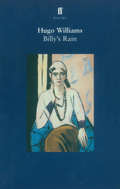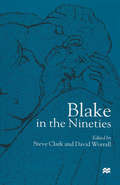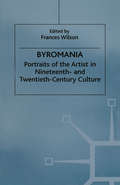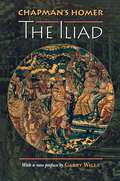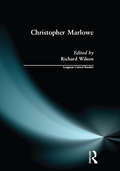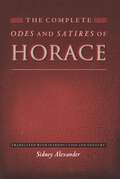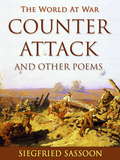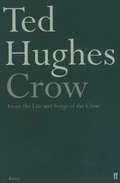- Table View
- List View
Sweet Machine: Poems (Cape Poetry Ser.)
by Mark DotyThe three books that brought Mark Doty acclaim - the poetry collections My Alexandria and Atlantis, and the prose memoir Heaven's Coast - dealt unflinchingly with love and its loss. The poems in this new book are from a man transfigured and elevated by grief, and the tone throughout is one of celebration at the majesty, the impossible splendour of the living world. Whether the subject is golden retrievers or humpback whales, Delft tiles or Murano glass, lilacs on Third Avenue or turtles on Broadway, these are exquisite, transcendent hymns of praise: sensuous, brilliant and thrillingly alive.
Thomas Hardy: Everyman's Poetry (Everyman's Poetry)
by Thomas HardyBoth major novelist and major poet, with a distinctive off-beat and intensely personal style, Hardy is a modern writer born out of his time.
Unspeakable ShaXXXspeares, Revised Edition: Queer Theory and American Kiddie Culture
by NA NAUnspeakable ShaXXXspeares is a savvy look at the wide range of adaptations, spin-offs, and citations of Shakespeare's plays in 1990s popular culture. What does it say about our culture when Shakespearean references turn up in television episodes of The Brady Bunch and Gilligan's Island, films such as In and Out and My Own Private Idaho, and hardcore porn adaptations of Hamlet and Romeo and Juliet? Burt reads the reception of these often quite bad replays in relation to contemporary youth culture and the "queering" of Shakespeare.
The Waste Land and Other Poems: Including The Love Song Of J. Alfred Prufrock (Barnes And Noble Classics Ser.)
by T. S. EliotApril is the cruellest month, breedingLilacs out of the dead land, mixingMemory and desire, stirringDull roots with spring rain . . .Published in 1922, The Waste Land was the most revolutionary poem of its time, offering a devastating vision of modern civilisation which has lost none of its power as we enter a new century.
Yeats Annual No. 13 (Yeats Annual)
by Warwick GouldYeats Annual is the leading international research-level journal devoted to the greatest twentieth-century poet in the English language. In this number there are new essays on Yeats's theatre by leading scholars such as Richard Allen Cave, Gregory N. Eaves and Masaru Sekine, while scholars from nine countries including Peter L. Caracciolo and Paul Edwards, Maneck H. Daruwala, William F. Halloran, Elisabeth Heine and Colleen MacKenna address such matters as 'Yeats and Maud Gonne: Marriage and the Astrological Record, 1908-9', Yeats's relations with Fiona Macleod and with Wyndham Lewis, the Ghost of Wordsworth, Philip Larkin and Seamus Heaney. There are new essays on A Vision , shorter bibliographical notes and reviews of ten new studies.
Living in Time: The Poetry of C. Day Lewis
by Albert GelpiThe Oxford poets of the 1930s--W. H. Auden, C. Day Lewis, Stephen Spender, and Louis MacNeice--represented the first concerted British challenge to the domination of twentieth-century poetry by the innovations of American modernists such as Ezra Pound and William Carlos Williams. Known for their radical politics and aesthetic conservatism, the "Auden Generation" has come to loom large in our map of twentieth century literary history. Yet Auden's voluble domination of the group in its brief period of association, and Auden's sway with critics ever since, has made it difficult to hear the others on their own terms and in their own distinct voices. Here, rendered in eloquent prose by one of our most distinguished critics of modern poetry, is the first full-length study of the poetry of C. Day Lewis, a book that introduces the reader to a profoundly revealing and beautifully wrought record of his poetry against the cultural and literary ferment of this century. Albert Gelpi explores in three expansive sections the major periods of the poet's development, beginning with the emergence of Day Lewis in the thirties as the most radical of the Oxford poets. An artist who sought through poetry a way of "living in time" without traditional religious assurances, Day Lewis went further than his friends in seeking to forge a revolutionary poetry out of his commitment to Marxism. When Stalinism led to his resignation from the Communist Party, Day Lewis in the forties went on to shape a rich, fiercely perceptive poetry out of the convergence of the wartime crisis with the explosive events of his own inner life, intensified by the erotics of a decade-long affair. Returning to his Irish roots and meditating on the persistent tension between agnosticism and faith in the work of his third and final period, Day Lewis wrote some of the most moving poems in the language about mortality and dying, the limits and possibilities of human striving. Through the traumatic changes of his life C. Day Lewis came increasingly to depend on the intricacies of poetry itself as a way of living in time. His abiding belief in the psychological and moral functions of poetry impelled him in his critical writings and in his own poetic practice to delineate a modern poetics that presents an effective alternative to the elitist experimentation associated with Modernism. This vital revisionist reading of Day Lewis demonstrates that much of his best work was written after the thirties and establishes him as one of the most significant and accomplished British poets of the modern period.
Abirami Andhadhi
by Abirami Pattar Kavingar KannadasanWhen Abirami Pattar's life was in danger,the Goddess Abirami manifested herself before pattar to save his life and threw her thadanga over the sky such that it shined with bright light upon the horizon.The hymns on the Goddess sung by the pattar is Abhirami Andhadhi.
Andrew Marvell (Longman Critical Readers)
by Thomas HealyAndrew Marvell brings together ten recent and critically informed essays by leading scholars on one of the most challenging and important seventeenth-century poets. The essays examine Marvell's poems, from lyrics, such as 'To His Coy Mistress' and 'The Nymph Complaining for the Death of her Fawn', to celebrations of Cromwell and Republican Civil War culture and his biting Restoration satires. Representing the most significant critical trends in Marvell criticism over the last twenty years, the essays and the authoritative editorial work provide an excellent introduction to Marvell's work. Students of Renaissance and seventeenth-century literature, English Civil War writing, and seventeenth-century social and cultural history will find this collection a useful guide to helping them appreciate and understand Marvell's poetry.
Andrew Marvell (Longman Critical Readers)
by Thomas HealyAndrew Marvell brings together ten recent and critically informed essays by leading scholars on one of the most challenging and important seventeenth-century poets. The essays examine Marvell's poems, from lyrics, such as 'To His Coy Mistress' and 'The Nymph Complaining for the Death of her Fawn', to celebrations of Cromwell and Republican Civil War culture and his biting Restoration satires. Representing the most significant critical trends in Marvell criticism over the last twenty years, the essays and the authoritative editorial work provide an excellent introduction to Marvell's work. Students of Renaissance and seventeenth-century literature, English Civil War writing, and seventeenth-century social and cultural history will find this collection a useful guide to helping them appreciate and understand Marvell's poetry.
The Angel’s Corpse (Semaphores and Signs)
by P. ColilliWith the great merit of Aristotle's Poetics , poetic logic became a theoretical activity endowed with a philosophical nature allowing it to be more philosophical than the pure representation of existence. Today, however, the theoretical status of poetic logic has been greatly demoted. The Angel's Corpse restores to poetic logic (or lyric philosophy) the cognitive and epistemological significance attributed to it by Aristotle. The Angel's corpse (the central metaphor in this restoration) is a sign-post beyond which there exists an uncharted terrain of human signification. This terrain is expressed in terms of lyric philosophy and its universal trait is a shocking into reawakening, which is linked to the dissolution of the repetitive logic of history. With this book, Colilli aims to bring to life the traits that are close to the Angel and which amount to a new philosophy of culture and interpretation. This philosophy is free from the ideological burden of previous systems, but pivots its cognito-epistemological premises on the idea of reawakening.
Bacchus in Romantic England: Writers and Drink 1780-1830 (Romanticism in Perspective:Texts, Cultures, Histories)
by A. TaylorBacchus in Romantic England describes real drunkenness among writers and ordinary people in the Romantic age. It grounds this 'reality' in writings by doctors and philanthropists from 1780 onwards, who describe an epidemic of drunkenness. These commentators provide a context for the different ways that poets and novelists of the age represent drunkards. Wordsworth writes poems and essays evaluating the drunken career of his model Robert Burns. Charles Lamb's essays and letters reveal a real and metaphorical preoccupation with his own drinking as a way of disguising his personal suffering; his companion Coleridge writes drinking songs, essays about drunkenness, and meditations about his own weakness of will that show both festive inebriety and consciousness of an inward abyss; Coleridge's son Hartley, whose fate his father had prophesied, experiences drunkenness as the life-long humiliation described in his poems and letters. Keats's complex dionysianism runs through 'Endymion' and the late odes, setting him at odds with his temperate hero Milton. Men in the Romantic age, such as Sheridan, Byron, Moor, and Clare, celebrate rowdy friendship with tales and songs of drinking; Romantic women novelists such as Smith, Edgeworth and Wollstonecraft depict these men stumbling home to abuse their wives. Although excessive drinking is real in the period, observers and participants can still maintain ambivalence about its power to release or to debase the human being.
The Ballad of HMS Belfast: A Compendium Of Belfast Poems
by Ciaran CarsonThis compendium, made from Ciaran Carson’s previous collections, reveals one of the most remarkable and sustained tours de force in contemporary poetry: the poet’s reimaginign of his native city of Belfast. Carson introduces the reader to a city as full of surreal narrative and imaginative possibility as Borges’ Buenos Aires or Calvino’s Venice; at the same time he never shirks from taking a hard look at the city in all its political and cultural complexity. In its refusal to simplify or romanticize, The Ballad of HMS Belfast is an indispensable guidebook to a city few will know exists. ‘He is the master of the long line; these poems are manic, frightening and funny, and somehow manage to catch the tone of life in modern Belfast’ John Banville, Irish Times ‘It is about Belfast past and present and is full of surprises, savage and witty, human and extravagant. His voice is truly original, both intelligent and passionate’ A. S. Byatt, Sunday Times Books of the Year
Bandanna
by Paul MuldoonFollowing his highly-praised Shining Brow (1993), which was also written as an opera libretto for the American composer Daron Aric Hagen, Paul Muldoon's Bandanna takes us into very different territory. Its action is set in a small town on the Mexican border; it includes illegal immigrants and corrupt law officers among its dramatis personae; but at its heart is an old-fashioned tale of sexual jealousy and murderous revenge. The drama is powered by a strong emotional thrust, most of it conveyed in the form of popular song, and leading to a devastating climax. Bandanna demonstrates yet again the ever-increasing range of this most versatile of poets.
Billy's Rain
by Hugo WilliamsThe fifty poems in Billy's Rain chart the course of a love affair, now ended. Its complications, obsessions, evasions, secret joys and emotional pitfalls are explored with all the subtlety and irony of which Hugo Williams, among contemporary poets, is the acknowledged master. These are brilliant, wry and moving elegies for a love affair.
Blake in the Nineties
by Steve Clark David WorrallThe 1990s have witnessed a major reassessment of Blake initiated by a new and more rigorous comprehension of his modes of production, which in turn has led to re-evaluation of other literary and cultural contexts for his work. Blake in the Nineties grapples with the implications of the new bibliography for Blake studies, in its editorial, interpretative, and historical dimensions. As well as providing an international overview of recent Blake criticism, the collection contributes to current debates in a variety of disciplines dealing with the Romantic period, including art history, counter-Enlightenment-scholarship, theology and hermeneutic theory.
Byromania: Portraits of the Artist in Nineteenth- and Twentieth-Century Culture
by Frances WilsonThis collection of essays by leading Byronists explores the development of the myth of Byron and the Byronic from the poet's self-representations to his various appearances in nineteenth- and twentieth-century literature and in drama, film and portraiture. Byromania (as Annabella Milbanke named the frenzied reaction to Byron's poetry and personality) looks at the phenomena of Byronism through a variety of critical perspectives, and it is designed to appeal to both an academic and a popular readership alike.
C. Subramania Bharathiyar Padalkal - Part II
by C. Subramaniya BharathiyarBharathiar’s songs are eye openers and in the nature of awakening the spirit of the readers. This is a collection of Poems of Wisdom (25 Poems), Variety Poems (11 Poems) and Autobiography in poetic format.
Chapman's Homer: The Iliad (Bollingen Series #673)
by HomerGeorge Chapman's translations of Homer are the most famous in the English language. Keats immortalized the work of the Renaissance dramatist and poet in the sonnet "On First Looking into Chapman's Homer." Swinburne praised the translations for their "romantic and sometimes barbaric grandeur," their "freshness, strength, and inextinguishable fire." The great critic George Saintsbury (1845-1933) wrote: "For more than two centuries they were the resort of all who, unable to read Greek, wished to know what Greek was. Chapman is far nearer Homer than any modern translator in any modern language." This volume presents the original (1611) text of Chapman's translation of the Iliad, making only a small number of modifications to punctuation and wording where they might confuse the modern reader. The editor, Allardyce Nicoll, provides an introduction and a glossary. Garry Wills contributes a preface, in which he explains how Chapman tapped into the poetic consonance between the semi-divine heroism of the Iliad's warriors and the cosmological symbols of Renaissance humanism.
Christopher Marlowe (Longman Critical Readers)
by Richard WilsonChristopher Marlowe has provoked some of the most radical criticism of recent years. There is an elective affinity, it seems, between this pre-modern dramatist and the post-modern critics whose best work has been inspired by his plays. The reason suggested by this collection of essays is that Marlowe shares the post-modern preoccupation with the language of power - and the power of language itself. As Richard Wilson shows in his introduction, it is no accident that the founding essays of New Historicism were on Marlowe; nor that current Queer Theorists focus so much on his images of gender and homosexuality. Marlowe staged both the birth of the modern author and the origin of modern sexual desire, and it is this unique conjunction that makes his drama a key to contemporary debates about the state and the self: from pornography to gays in the military.Gay Studies, Cultural Materialism, New Historicism and Reader Response Criticism are all represented in this selection, which the introduction places in the light not only of theorists like Althusser, Bataille and Bakhtin, but also of artists and writers such as Jean Genet and Robert Mapplethorpe. Many of the essays take off from Marlowe's extreme dramatisations of arson, cruelty and aggression, suggesting why it is that the thinker who has been most convincingly applied to his theatre is the philosopher of punishment and pain, Michel Foucault. Others explore the exclusiveness of this all-male universe, and reveal why it remains so offensive and impenetrable to feminism. For what they all make disturbingly clear is Marlowe's violent, untamed difference from the clichés and correctness of normative society.
Christopher Marlowe (Longman Critical Readers)
by Richard WilsonChristopher Marlowe has provoked some of the most radical criticism of recent years. There is an elective affinity, it seems, between this pre-modern dramatist and the post-modern critics whose best work has been inspired by his plays. The reason suggested by this collection of essays is that Marlowe shares the post-modern preoccupation with the language of power - and the power of language itself. As Richard Wilson shows in his introduction, it is no accident that the founding essays of New Historicism were on Marlowe; nor that current Queer Theorists focus so much on his images of gender and homosexuality. Marlowe staged both the birth of the modern author and the origin of modern sexual desire, and it is this unique conjunction that makes his drama a key to contemporary debates about the state and the self: from pornography to gays in the military.Gay Studies, Cultural Materialism, New Historicism and Reader Response Criticism are all represented in this selection, which the introduction places in the light not only of theorists like Althusser, Bataille and Bakhtin, but also of artists and writers such as Jean Genet and Robert Mapplethorpe. Many of the essays take off from Marlowe's extreme dramatisations of arson, cruelty and aggression, suggesting why it is that the thinker who has been most convincingly applied to his theatre is the philosopher of punishment and pain, Michel Foucault. Others explore the exclusiveness of this all-male universe, and reveal why it remains so offensive and impenetrable to feminism. For what they all make disturbingly clear is Marlowe's violent, untamed difference from the clichés and correctness of normative society.
The Complete Odes and Satires of Horace
by Horace Sidney AlexanderHorace has long been revered as the supreme lyric poet of the Augustan Age. In his perceptive introduction to this translation of Horace's Odes and Satires, Sidney Alexander engagingly spells out how the poet expresses values and traditions that remain unchanged in the deepest strata of Italian character two thousand years later. Horace shares with Italians of today a distinctive delight in the senses, a fundamental irony, a passion for seizing the moment, and a view of religion as aesthetic experience rather than mystical exaltation--in many ways, as Alexander puts it, Horace is the quintessential Italian. The voice we hear in this graceful and carefully annotated translation is thus one that emerges with clarity and dignity from the heart of an unchanging Latin culture. Alexander is an accomplished poet, novelist, biographer, and translator who has lived in Italy for more than thirty years. Translating a poet of such variety and vitality as Horace calls on all his literary abilities. Horace (Quintus Horatius Flaccus, 65-8 bce), was born the son of a freed slave in southern rural Italy and rose to become one of the most celebrated poets in Rome and a confidante of the most powerful figures of the age, including Augustus Caesar. His poetry ranges over politics, the arts, religion, nature, philosophy, and love, reflecting both his intimacy with the high affairs of the Roman Empire and his love of a simple life in the Italian countryside. Alexander translates the diverse poems of the youthful Satires and the more mature Odes with freshness, accuracy, and charm, avoiding affectations of archaism or modernism. He responds to the challenge of rendering the complexities of Latin verse in English with literary sensitivity and a fine ear for the subtleties of poetic rhythm in both languages. This is a major translation of one of the greatest of classical poets by an acknowledged master of his craft.
The Complete Odes and Satires of Horace (The Lockert Library of Poetry in Translation #126)
by HoraceHorace has long been revered as the supreme lyric poet of the Augustan Age. In his perceptive introduction to this translation of Horace's Odes and Satires, Sidney Alexander engagingly spells out how the poet expresses values and traditions that remain unchanged in the deepest strata of Italian character two thousand years later. Horace shares with Italians of today a distinctive delight in the senses, a fundamental irony, a passion for seizing the moment, and a view of religion as aesthetic experience rather than mystical exaltation--in many ways, as Alexander puts it, Horace is the quintessential Italian. The voice we hear in this graceful and carefully annotated translation is thus one that emerges with clarity and dignity from the heart of an unchanging Latin culture. Alexander is an accomplished poet, novelist, biographer, and translator who has lived in Italy for more than thirty years. Translating a poet of such variety and vitality as Horace calls on all his literary abilities. Horace (Quintus Horatius Flaccus, 65-8 bce), was born the son of a freed slave in southern rural Italy and rose to become one of the most celebrated poets in Rome and a confidante of the most powerful figures of the age, including Augustus Caesar. His poetry ranges over politics, the arts, religion, nature, philosophy, and love, reflecting both his intimacy with the high affairs of the Roman Empire and his love of a simple life in the Italian countryside. Alexander translates the diverse poems of the youthful Satires and the more mature Odes with freshness, accuracy, and charm, avoiding affectations of archaism or modernism. He responds to the challenge of rendering the complexities of Latin verse in English with literary sensitivity and a fine ear for the subtleties of poetic rhythm in both languages. This is a major translation of one of the greatest of classical poets by an acknowledged master of his craft.
The Complete Odes and Satires of Horace (The Lockert Library of Poetry in Translation #126)
by HoraceHorace has long been revered as the supreme lyric poet of the Augustan Age. In his perceptive introduction to this translation of Horace's Odes and Satires, Sidney Alexander engagingly spells out how the poet expresses values and traditions that remain unchanged in the deepest strata of Italian character two thousand years later. Horace shares with Italians of today a distinctive delight in the senses, a fundamental irony, a passion for seizing the moment, and a view of religion as aesthetic experience rather than mystical exaltation--in many ways, as Alexander puts it, Horace is the quintessential Italian. The voice we hear in this graceful and carefully annotated translation is thus one that emerges with clarity and dignity from the heart of an unchanging Latin culture. Alexander is an accomplished poet, novelist, biographer, and translator who has lived in Italy for more than thirty years. Translating a poet of such variety and vitality as Horace calls on all his literary abilities. Horace (Quintus Horatius Flaccus, 65-8 bce), was born the son of a freed slave in southern rural Italy and rose to become one of the most celebrated poets in Rome and a confidante of the most powerful figures of the age, including Augustus Caesar. His poetry ranges over politics, the arts, religion, nature, philosophy, and love, reflecting both his intimacy with the high affairs of the Roman Empire and his love of a simple life in the Italian countryside. Alexander translates the diverse poems of the youthful Satires and the more mature Odes with freshness, accuracy, and charm, avoiding affectations of archaism or modernism. He responds to the challenge of rendering the complexities of Latin verse in English with literary sensitivity and a fine ear for the subtleties of poetic rhythm in both languages. This is a major translation of one of the greatest of classical poets by an acknowledged master of his craft.
Counter-Attack and Other Poems (The World At War)
by Siegfried SassoonSiegfried Loraine Sassoon, CBE, MC (8 September 1886 – 1 September 1967) was an English poet, writer, and soldier. Decorated for bravery on the Western Front,[1] he became one of the leading poets of the First World War. This collection of poems was first published in May 1918. (Excerpt from Wikipedia)
Crow: From The Life And Songs Of The Crow (Faber Pocket Poetry Ser. #Vol. 5)
by Ted HughesCrow was Ted Hughes's fourth book of poems for adults and a pivotal moment in his writing career. In it, he found both a structure and a persona that gave his vision a new power and coherence. A deep engagement with history, mythology and the natural world combine to forge a work of impressive and unsettling force. 'English poetry has found a new hero and nobody will be able to read or write verse now without the black shape of Crow falling across the page.' Peter Porter
